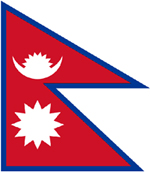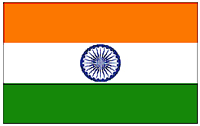-
-
Country Name:
-
India
-
Nationality:
-
Indian
-
Capital:
-
New Delhi
-
Government type:
-
Federal Republic
-
Administrative divisions:
-
29 states and 7 union territories*; Andaman and Nicobar Islands*, Andhra Pradesh, Arunachal Pradesh, Assam, Bihar, Chandigarh*, Chhattisgarh, Dadra and Nagar Haveli*, Daman and Diu*, Delhi*, Goa, Gujarat, Haryana, Himachal Pradesh, Jammu and Kashmir, Jharkhand, Karnataka, Kerala, Lakshadweep*, Madhya Pradesh, Maharashtra, Manipur, Meghalaya, Mizoram, Nagaland, Odisha, Puducherry*, Punjab, Rajasthan, Sikkim, Tamil Nadu, Telangana, Tripura, Uttar Pradesh, Uttarakhand, West Bengal
-
Location:
-
Southern Asia, bordering the Arabian Sea and the Bay of Bengal, between Burma and Pakistan
-
Geographic coordinates:
-
20 00 N, 77 00 E
-
Map references
-
Asia
-
Area:
-
Total: 3,287,263 sq km
-
Land: 2,973,193 sq km
-
Water: 314,070 sq km
-
Land Boundaries:
-
Total: 13,888 km
-
Border Countries:
-
Bangladesh 4,142 km, Bhutan 659 km, Burma 1,468 km, China 2,659 km, Nepal 1,770 km, Pakistan 3,190 km
-
Climate
-
varies from tropical monsoon in south to temperate in north
-
Terrain:
-
upland plain (Deccan Plateau) in south, flat to rolling plain along the Ganges, deserts in west, Himalayas in north
-
Elevation extremes:
-
Lowest Point: Indian Ocean 0 m
-
Highest Point: Kanchenjunga 8,598 m
-
Natural Resources:
-
coal (fourth-largest reserves in the world), iron ore, manganese, mica, bauxite, rare earth elements, titanium ore, chromite, natural gas, diamonds, petroleum, limestone, arable land
-
Land use:
-
Arable land: 47.87%
-
Permanent crops:3.74%
-
Other:48.39% (2011)
-
Irrigated land: 663,340 sq km (2008)
-
GDP (purchasing power parity):
-
$42.06 billion (2013 est.)
-
$40.57 billion (2012 est.)
-
$38.7 billion (2011 est.)
-
note: data are in 2013 US dollars
-
GDP (official exchange rate):
-
$19.34 billion (2013 est.)
-
GDP - real growth rate:
-
3.6% (2013 est.)
-
4.9% (2012 est.)
-
3.4% (2011 est.)
-
GDP - per capita (PPP):
-
$1,500 (2013 est.)
-
$1,500 (2012 est.)
-
$1,400 (2011 est.)
-
note: data are in 2013 US dollars
-
Population:
-
1,236,344,631 (July 2014 est.)
-
Age structure:
-
0-14 years: 28.5% (male 187,016,401/female 165,048,695)
-
15-24 years: 18.1% (male 118,696,540/female 105,342,764)
-
25-54 Years: 40.6% (male 258,202,535/ female 243,293,143)
-
55-64 Years: 7% (male 43,625,668 / female 43,175,111)
-
65 years and over: 5.7% (male 34,133,175/female 37,810,599) (2014 est.)
-
Median age:
-
total: 27 years
-
male: 26.4 years
-
female: 27.7 years (2014 est.)
-
Population growth rate:
-
1.25% (2014 est.)
-
Birth rate:
-
19.89 births/1,000 population (2014 est.)
-
Death rate:
-
7.35 deaths/1,000 population (July 2014 est.)
-
Net migration rate:
-
-0.05 migrant(s)/1,000 population (2014 est.)
-
Urbanization:
-
urban population: 31% of total population (2011)
-
rate of urbanization: 2.47% annual rate of change (2010-15 est.)
-
Sex ratio:
-
at birth: 1.12 male(s)/female
-
under 15 years: 1.13 male(s)/female
-
15-24 Years: 1.13 male(s)/female
-
25-54 years: 1.06 male(s)/female
-
55-64 Years: 1.08 male(s)/female
-
total population: 1.08 male(s)/female (2014 est.)
-
total population:1.08 male(s)/female (2014 est.)
-
Infant mortality rate:
-
total: 43.19 deaths/1,000 live births
-
male: 41.9 deaths/1,000 live births
-
female: 44.63 deaths/1,000 live births (2014 est.)
-
Life expectancy at birth:
-
total population: 67.8 years
-
male: 66.68 years
-
female: 69.06 years (2014 est.)
-
Total fertility rate:
-
2.51 children born/woman (2014 est.)
-
Chief of state:
-
President Pranab MUKHERJEE (since 22 July 2012); Vice President Mohammad Hamid ANSARI (since 11 August 2007)
-
Head of government:
-
Prime Minister Narendra MODI (since 26 May 2014)
-
Cabinet:
-
Union Council of Ministers appointed by the president on the recommendation of the prime minister (For more information visit the World Leaders website )
-
Elections:
-
president elected by an electoral college consisting of elected members of both houses of Parliament and the legislatures of the states for a five-year term (no term limits); election last held in July 2012 (next to be held in July 2017); vice president elected by both houses of Parliament for a five-year term; election last held in August 2012 (next to be held in August 2017); prime minister chosen by parliamentary members of the majority party following legislative elections
-
Election Results:
-
Pranab MUKHERJEE elected president; percent of vote - Pranab MUKHERJEE 69.31%, Purno SANGMA - 30.69%
-
Ethnic Groups:
-
Indo-Aryan 72%, Dravidian 25%, Mongoloid and other 3% (2000)
-
Languages:
-
Hindi 41%, Bengali 8.1%, Telugu 7.2%, Marathi 7%, Tamil 5.9%, Urdu 5%, Gujarati 4.5%, Kannada 3.7%, Malayalam 3.2%, Oriya 3.2%, Punjabi 2.8%, Assamese 1.3%, Maithili 1.2%, other 5.9%
-
Note: English enjoys the status of subsidiary official language but is the most important language for national, political, and commercial communication; Hindi is the most widely spoken language and primary tongue of 41% of the people; there are 14 other official languages: Bengali, Telugu, Marathi, Tamil, Urdu, Gujarati, Malayalam, Kannada, Oriya, Punjabi, Assamese, Kashmiri, Sindhi, and Sanskrit; Hindustani is a popular variant of Hindi/Urdu spoken widely throughout northern India but is not an official language (2001 census)
-
Religions:
-
Hindu 80.5%, Muslim 13.4%, Christian 2.3%, Sikh 1.9%, other 1.8%, unspecified 0.1% (2001 census)
Source: CIA World Factbook
Visit Website for more details

